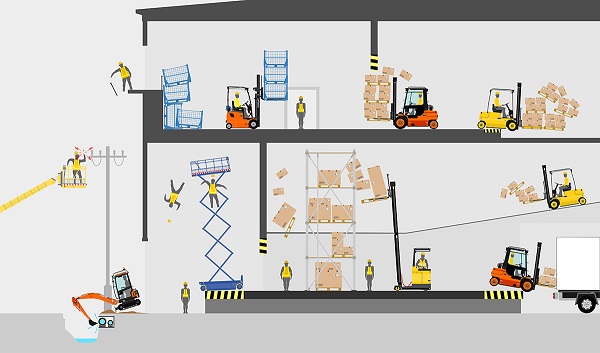
The Industrial Truck Association estimates 4.5 million people in the U.S. operate forklifts in more than 300 different industries. In Texas, industrial truck firms generate $2.7 billion in terms of gross value added, the second-highest economic impact of any state in the nation.
Despite the positive economic impact, forklift safety hazards can also bring high personal and corporate costs in terms of injuries and days away from work. According to the U.S. Bureau of Labor Statistics, 310 Texas workers were injured in 2018 as a result of forklift incidents. Over a quarter of those injured required hospital stays resulting in more than 31 days away from work. Five of the injuries were fatal.
Accidents such as collisions, tip-overs, and workers struck by forklifts are reasons why employees need to follow proper safety measures at all times. The following tips can help keep forklift drivers safe during their shifts and throughout their careers:
1Train and authorize drivers
Allow only trained and authorized employees to operate forklifts. Re-authorize forklift operators at least every three years.
2Check equipment before operating
Use a written checklist to inspect forklifts before each shift’s operations. Report any damage or problems to management. Remove forklifts in need of repairs from service.
3Buckle up
Overturned forklifts are a leading cause of forklift-related injuries and fatalities. Always wear a seatbelt when the forklift has one. Retrofit sit-down forklifts with seatbelts if there is an overhead guard. Seatbelts can keep forklift operators from getting crushed by the overhead guard or roll cage in the event of a tip-over accident.
4Wear personal protective equipment (PPE)
Use personal protective equipment as required by the employer, such as hard hats, safety shoes, high-visibility clothing, and glasses.
5Don’t exceed a forklift’s weight capacity
Refer to the forklift’s capacity plate. If the weight of the load is unknown, pay attention to how readily it's lifted by the forklift. If possible, keep the heaviest portion of the load closest to the mast. Tilt loads back before raising, lowering, or moving them. If the load must be lifted on the tips of the forks or with fork extenders, the forklift’s lifting capacity is decreased.
6Operate at a safe speed
Drive at the speed of a moderate walk. Take turns slowly to minimize the risk of tipping.
7Use caution on ramps
Keep the load on the high side when going up and down ramps. When going up a ramp, sound the horn. To avoid a forklift tip-over, never turn on a ramp.
8Use the horn to avoid collisions
Forklift operators should use the horn at cross aisles and obstructed areas to help alert pedestrians or other operators. Blow the horn when entering a building from the outside.
9Know the clearance
Watch your clearances when operating the forklift. Have clear visibility of the work area and ensure enough room is available when raising, loading, and operating the forklift. Watch for overhead obstructions such as lights and sprinkler pipes when lifting loads. Never raise or lower the load while traveling, except to clear obstacles in the path of travel. In these cases, stop, raise the load, clear the obstacle, stop again, lower the load, and proceed. Be aware that forklifts steer from the rear wheels causing the rear end to swing on turns. Keep a safe distance from the platform and ramp edges.
10No riders
Never give rides or use the forks to lift people, except in a lift cage secured to the lift mechanism, preferably by chaining.
DWC has these publications: Forklifts/Powered Industrial Trucks Workplace Programs, Forklift Load Handling, and Forklift Rules of the Road. You can also contact a DWC Safety Training Specialist at www.txsafetyatwork.com, safetytraining@tdi.texas.gov, or 1-800-2252-7031, option 2.
Additional Resources:
NIOSH 2001-109 Forklift Safety
